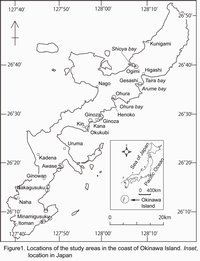Special Program for International Students
GRADUATE COURSE IN EARTH SCIENCE
& GEOENVIRONMENTAL SCIENCE
Current students
Diallo Ibrahima M’Bemba (Guinea)
Email: ibrahimacentral @yahoo.fr
Thesis title: Geochemical evaluation of mangrove and coastal environment of Okinawa Island, Japan.
Supervisor: Professor Hiroaki Ishiga (2014-2017).
Trace metals are among the most persistent pollutants in aquatic ecosystem because of their resistance to decomposition in natural conditions (Arnason & Fletcher, 2003). Trace metals in the aquatic environment originate from both natural processes (e.g., weathering and erosion of rocks and soils) and anthropogenic activity such as agricultural runoff and sewage disposal (Liaghati et al., 2003). These enriched trace metals may become a potential source of pollution.
Okinawa Island, located in southern Japan, is the largest in the Ryūkyū Islands archipelago (Figure1). The island is characterized by the production of sugar cane, pineapple, papaya, and other tropical fruits. Other economic activities include sugar refining, cattle rearing, tuna fishing, and pineapple canning. In addition, Okinawa Island is characterized by a variety of coastal ecosystem environments, including beaches and mangrove forests. These coastal ecosystems play a major role in the mobilization and distribution of trace elements, which may potentially pollute or contaminate the adjacent aquatic ecosystems.
Contamination of aquatic ecosystems by trace metals can be confirmed in water, organisms, and sediments (Albering et al., 1999; Sprenke et al., 2000). Sediments are the ultimate sink for anthropogenic chemical contaminants that may be contained in effluents originating from industrial, urban, recreational, and agricultural activities (Hatji et al., 2002; Apitz et al., 2005). The geochemical analysis of sediments thus provides an insight into the pollution status of the environment with respect to diverse chemical elements such as trace metals.
Over the last few decades, many geochemical studies of coastal sediments have been carried out to evaluate the extent of contamination from trace metals (e.g. Daskalakis & O’connor, 1995; Long et al., 1998; Ishiga et al., 2000a). Consequently, the present study aims to determine trace and major element concentrations in the north and south of Okinawa Island, to examine their distribution patterns and sources. These data will be used to assess the pollution status of the sediments using contamination factors and the geoaccumulation index, and to evaluate potential toxic effects of the metal concentrations on aquatic biota, by reference to established international sediment quality guidelines.
References
Albering, H.J, Rila, J.P, Moonen, E.J.C, Hoogewerff, J.A, & Kleinjans, J.C.S. (1999).
Human health risk assessment in relation to environmental pollution of two artificial freshwater lakes
in the Netherlands.
Environment Health Perspective 107(1):27–35.
http://dx.doi.org/10.1289/ehp.9910727
Arnason, J.G, & Fletcher, B.A. (2003).
A 40+ year record of Cd, Hg, Pb, and U deposition in sediments of Patroon Reservoir, Albany County, NY, USA.
Environmental Pollution ,123:383–391.
http://dx.doi.org/10.1016/S0269-7491(03)00015-0
Daskalakis, K.D, & O’Connor, T.P. (1995).
Distribution of chemical concentrations in US coastal and estuarine sediment.
Marine Environmental Resources, 40(4):381–398.
http://dx.doi.org/10.1016/0141-1136(94)00150-N
Hatji, V., Birch, G. F., & Hill, D. M. (2002).
Spatial and temporal variability of particulate trace metals in Port Jackson Estuary, Australia.
Estuary Coast Shelf Science, 53, 63–77.
http://dx.doi.org/10.1006/ecss.2001.0792
Ishiga, H., Nakamura,T., Sampei, Y., Tokuoka, T., & Takayasu, K. (2000a).
Geochemical record of the Holocene Jomon transgression and human activity in coastal lagoon sediments of the San’in district, SW Japan.
Global Planetary Change, 25:223– 237.
http://dx.doi.org/10.1016/S0921-8181(00)00005-9
Liaghati, T., Preda, M., & Cox, M. (2003).
Heavy metal distribution and controlling factors within coastal plain sediments, Bells Creek catchment, southeast Queensland, Australia.
Environment International, 29, 935–948.
http://dx.doi.org/10.1016/S0160-4120(03)00060-6
Long, E.R., Field, L.J., & MacDonald, D.D. (1998).
Predicting toxicity in marine sediments with numerical sediment quality guidelines.
Environmental Toxicology and Chemical, 17:714–727.
http://dx.doi.org/10.1002/etc.5620170428
Sprenke, K.F., Rember, W.C., Bender, S.F., Hoffmann, M.L., Rabbi, F., & Chamberlain, V.E. (2000).
Toxic metal contamination in the lateral lakes of the Coeur d’Alene River valley, Idaho.
Environmental Geology, 39(6):575–586.
http://dx.doi.org/10.1007/s002540050469


